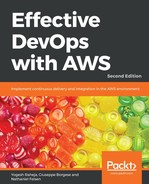In this chapter, we explored the concept of containers, using Docker and ECS. After exploring the basics of how Docker works, we created a container for our application. After running it locally, we created a new set of resources to run Docker containers on AWS. We did that using the DevOps best practices and used CloudFormation to generate our resources, treating our infrastructure as code. This allows us to keep those changes under source control. Resource-wise, we created an ECR repository to manage the different revisions of our containers. We also created two ECS clusters with auto scaling capabilities for staging and production, two ALBs to proxy the traffic to our containers, a set of tasks, and an ECS service, to configure and deploy our application.
Finally, we re-implemented a CI/CD pipeline. We did that by using CodeBuild, CodePipeline, and their integrations with CloudFormation.
We will continue improving our systems and we will implement one of the last key characteristics of DevOps; measuring everything. By taking advantage of a number of features that are present in the different services that we use, and by coupling them with other AWS services (such as CloudWatch), we will be able to implement a monitoring strategy for our infrastructure and services.
